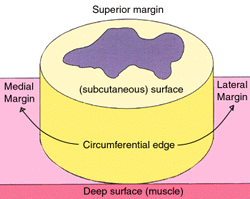Present Technology.
Present treatments for melanoma skin cancer include surgery and chemotherapy.
Surgery: During early stages of melanoma, the tumor can be removed by wide excison.

This image depicts wide excison performed on a small melanoma tumor by removing the infected area as well as the adjacent tissue and skin around it.
However, if the melanoma spreads to places where it cannot be safely removed, surgery will not work.
Chemotherpy: When the melanoma spreads and is surgically impossibe to remove, chemotherapy is usually administered and sometimes even combined with immunotherapy.
This method tries to counteract the effects of progressing melanoma by breaking its cell's DNA. It very rarely removes the whole cancer, but rather shrinks it down; mainly to slow the cancer growth and prolong the patient's life.

The animation above shows the chemotherpy attacking and breaking the melanoma DNA with the hopes of killing that cell.
The method of treating late stage melanoma fails to do its job and does do enough damage to the DNA to destroy the entire cancer. Since the method of treatment is faulty, this is the main reason the fatality rate for metastatic melanoma is very high.
Why It Fails: Base Excision Repair.
In cancer cells specifically, the implications of base excision repair is the major factor in the cells resiliencies to chemotherapy.
Cellular reaction to chemotherapy
When the melanoma DNA is damaged by the chemotherapy, the PARP proteins are activated and immediately fix the damages imposed. The cancer cells then become repaired with no damage.
Since there are no longer any damages, the cancer continues to spread and metastasizes throughout the body becoming more and more deadly.